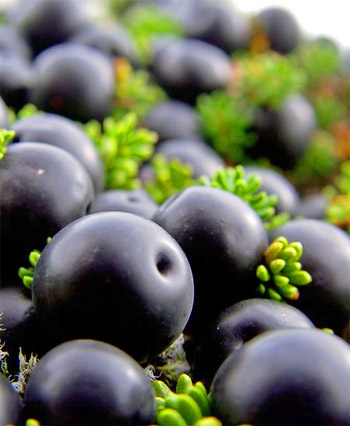|
|
|
 , ,
Font size |
Encyclopedia of Health Benefits of Berries

10. Crowberries:
These are dry black berries very similar to blueberry in taste and
appearance. They are used as natural food dye, in making pie and jelly. The
Native Americans use them to heal sore eyes. They have a low vitamin content
and high water content.
Black crowberries are grown in colder climates including Alaska, across the
Yukon Territory and Canada to Labrador, Newfoundland, and Greenland. Black
crowberry is also widely distributed throughout Northern Europe. These small
black berries are filled with antioxidants, manganese, copper, and vitamin
C�they�re packed with nutrients.
Choose firm, plump, dry crowberries that are dusty blue to black in color
and uniform in size.Refrigerate crowberries for 10 to 14 days in the
original container.
Nutrition Benefits of Black Crowberries
Low in fat, saturated fat free, cholesterol free, sodium free, and an
excellent source of manganese, copper, and vitamin C Although the crowberry
provides the third largest harvest of all berries (after blueberries and
lingonberries) it is almost unknown outside the arctic regions. In the
Nordic countries the use of wild berries has long traditions in home cooking
as well as for therapeutic purposes.
Crowberry is an evergreen shrub native to cool regions of North America,
Asia, and Europe. In southern hemisphere it is found on Falkland islands.
The fruits are black round berries.
It is interesting to note that crowberry is fighting other species by
producing a toxin. Crowberry leaves have small glands that produce batatasin
III. The leaves live two to four years, and when they die and end up on the
ground where they break down slowly, and continues to leak its water-soluble
toxin. The toxin blocks other species to grow what makes free living space
to the crowberries.
Crowberry is not edible raw unless as a replacement for water. Crowberry has
a taste that is slightly acidic and bitter. The berry contains tannins what
makes its taste unpleasant.
 It is typically used cooked, seldom fresh. The berries have been used as raw
material for juice, jelly, wine and sweets. Crowberries are eaten in akutaq,
Eskimo's ice cream. It is typically used cooked, seldom fresh. The berries have been used as raw
material for juice, jelly, wine and sweets. Crowberries are eaten in akutaq,
Eskimo's ice cream.
Crowberries are widely used in folk medicine for treating epilepsy,
paralysis, nervous disorders and anthrax. In Russia a medicine for treating
epilepsy (Empetrin) is produced. (1)
Crowberries have astringent and diuretic effect.
Crowberry is a rich (460 mg / 100 g berries) source of anthocyans. (2) The
increased interest in flavonoids and other phenolics as health-benefiting
compounds can lead to an increased usage of the crowberries.
Crowberries are a source of botanicals for preparation of cosmetic products.
Crowberry is not an economic important crop. The crowberry anthocyans are
potential source of natural colorants but largely unused. Due to the
toughness of the crowberry plant, it has been used as pan scrubbers and
brooms.
The ability of natural dyes to color textiles has been known since ancient
times. Crowberries are used as natural dyes for centuries. Old recipes from
Swedish Lapland proposed several different crowberry treatments and cooking
times to produce different shades of green, yellow and brown. Both the
berries and the plant were used for dying the textile.
Blueberries: They are dark-blue or purple in color. They are used in jams,
pur�e, juice, pies, and muffins. They contain high levels of antioxidants
and can help prevent many diseases, like stomach ailments, heart
degeneration, and heart diseases.
Huckleberries: These are small round berries that look and taste similar to
blueberries. They come in colors ranging from deep crimson to eggplant
purple. They are used to make excellent jams, pies, syrups, and
preservatives.
Bilberries: Bilberries are edible berries that are closely related to
blueberries and huckleberries. They are nearly black in color with a slight
hue of purple. The pulp is red or purple in color and can stain your fingers
while eating the raw fruit. They are very difficult to cultivate and fruits
are generally collected from the wild. They are used in different jams and
dishes or eaten raw.
Next..
Dated 12 March 2013

|
|
|
|
|
|
|









